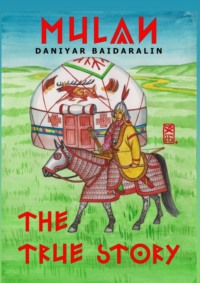Kitabı oku: «Mulan. The True Story»
© Daniyar Z. Baidaralin, 2020
ISBN 978-5-4498-8569-2
Created with Ridero smart publishing system
MULAN-BATYR
THE TRUE STORY
This happened long-long time in the Tuoba Wei Khanate of the Great Eurasian Steppe. The people of this khanate had a tribal name of Tabgachi, which means “people who braid their hair”, because both Tabgachi men and women had this traditional nomadic hairstyle.
Among the Tabgachi, there was one honorable tribe called Bulan. The named Bulan means “deer”, because the ancestors of the Bulan people were deer-breeding nomads of the Altai Region. Their insignia called Tamga was a beautiful deer with long antlers.
All men from the Bulan Tribe served in the Tabgachi Khans’ cavalry for many generations. They helped to defend the Tuoba Wei country from the northern nomads and this service was the considered the highest honor.
One old man of the Bulan Tribe had a sixteen year old daughter. Her name was Mulan, and everybody called her Mulan the Bulan. She had an older sister who was a famous local beauty and a little brother.
Mulan’s family lived in the plains north of the Yellow River. Further down north across the plains stood the Yan Mountains, beyond which began the endless plains of the Great Steppe. The nomadic ancestors of the Bulan Tribe were from beyond these mountains too. Back then they lived in mobile yurts and didn’t know anything about living in stationary houses.
But Mulan’s family was semi-nomadic, which means they had a house made of stone and next to it stood a raised traditional Tabgachi yurt. The yurt was an important part of the Mulan’s family household. They used the yurt as a dining hall and to host their guests.

Mulan’s family owned a big herd of sheep, a few horses, and a camel. Sheep provided her family with food and wool. Wool went to making thick felt for their yurt and floor mats, and as a material for threads used in weaving. Horses were their main transportation because nobody liked walking long-distances in these plains. To relocate their mobile yurt, they had to take it down and pack it, and only their mighty camel could carry it from place to place.
The Tabgachi built fenced cattle-pens where they kept their animals when they weren’t grazing in the pastures. When on pastures, the cattle would roam free and eat grass. Neighbors would gather their cattle in large herds and every family would send one member to watch after them. The teams of armed herdsmen would watch after the cattle and protect it from predators and thieves. Mulan, her older sister, and her little brother all have spent many days on the pastures watching after their cattle.
All Tabgachi men and women had to master ancient nomadic martial arts called The Five Weapons. The Five Weapons included the horsebow, spear, sword, battle axe, and dagger. Following this tradition, Mulan’s father taught his children the Five Weapons from a very young age.
Just like the northern nomads, the Tabgachi people were brave and never built high stone walls around their villages. They knew that the best defense against enemies was in their fast bows, long spears, and sharp swords.
If the enemies invaded, the Tabgachi watchmen on the tops of the hills would see them and light fires, signaling everybody about the danger. Then all Tabgachi servicemen would take their weapons, don their armor, hop on their war horses, gather in their military units, and meet the enemy head on.
Ücretsiz ön izlemeyi tamamladınız.
